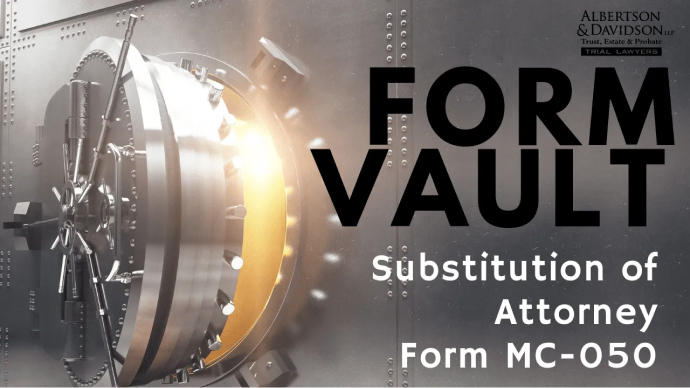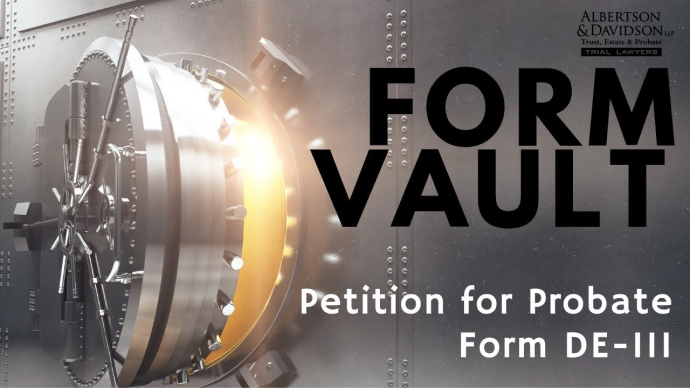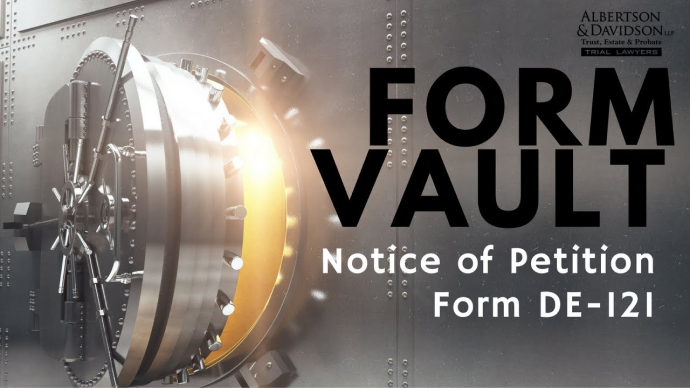Video Transcript
The following is an unedited, verbatim transcript of our video. It is not intended to be a stand-alone article.
Hi, this is Keith Davidson at Albertson & Davidson. In today’s form vault video, we’re going over the form Substitution of Attorney. This is the form that you need to use anytime you’re going to change attorneys or if you want your attorney to stop representing you and you want to start representing yourself in court, you have to file this form.
Form MC-050
So we’ll start off by going to the Judicial Council Forms and under the browse all forms tab, you’re going to want to go to Miscellaneous Forms. And today’s form is going to be MC-050 which Substitution of Attorney. The substitution of attorney form is really quite easy to fill out and typically, if you’re hiring a new lawyer, let’s say you’ve been representing yourself and you’re hiring a lawyer, the lawyer is going to fill this out for you. Or if you have one lawyer and you want to switch lawyers to a new lawyer, the new lawyer will usually fill out this form for you. But it’s good for you to know what this form is. So your attorney is still your attorney of record with the court until you file this form, so if you don’t want an attorney representing you in court anymore, you must file the Substitution of Attorney form.
It starts by your attorney, your new attorney, filling out the name and firm information at the top. So I’ve just put my own name in here, Keith A. Davidson at Albertson & Davidson. If you are representing yourself, you’re going to fire your attorney and you want to represent yourself, you just put in your own name and mailing address in here. You want to make sure you have the phone number where the court can reach you and the other parties can reach you, your email address, fax is optional, and then we’re going to put in who we represent. So this is our client, Nancy Smith. You’re then going to want to put in the county that your action is pending in. So if we were in Orange County, we’d put County of Orange and we’d go to the court website and find the street and mailing address for that court that the matter is pending in.
And then you have to put the case name, so if this was a Probate Estate or a Trust action let’s say, you could put down here “the Smith Family Trust,” that’s the name that we make up, and now that’s the case name. Whatever the case name is, you’ll just type it in here. And then you’ll have to put in the case number over here, and Orange County does not use this type of number, but we’ll make it easy because Orange County numbers are much more complicated. But whatever the case number is in your case, doesn’t matter what county you’re in, just put it into the case number box, and that way you can file it in the court.
Who is Filing the Substitution?
For the main part of the form, the court is asking you who is filing the substitution of attorney, so in our case, it’s going to be Nancy Smith is filing it. And the first question is, who is the former legal representative? Is it a party representing themselves or is it an attorney? So we’ll say that we’re taking over from another attorney and we’ll just make up a name, Bob Johnson, I don’t know anybody named Bob Johnson, so I’m not insulting any attorneys out there. But we’ll say that we’re taking over from an attorney named Bob Johnson. And then they want to know who’s the new legal representative, so you could either be representing yourself, in which case Nancy Smith would type in her own name, or you can say it’s an attorney, so in this case, I’m taking over the case, so I’m going to put in my name and I usually like to type in the firm name here to the extent I can fit in there. And then they want to know the new attorney’s bar number and of course mailing address so that everybody can get a hold of that attorney and do whatever is required for the case. And of course, you always want to put your phone number so that the parties and the court can reach you.
Next on number 3, the party making the substitution is either a plaintiff, defendant or a petitioner or respondent. Plaintiff and defendant is usually what you use in a lawsuit that’s filed in the civil department. If you’re in a lawsuit in the probate court, like a Trust matter or a Will matter, you’re probably going to be either a petitioner or respondent. Petitioner is the plaintiff, the respondent is the defendant. So here we’re going to say we represent petitioner. Now you notice this big box here that says “notice to parties applying to represent themselves.” Up here on number 2, there was an asterisk next to “parties representing self,” and what that asterisk is referring to is the information down in here in this box, and what this information is telling people is that if you’re any type of a representative, so if you’re a guardian, a conservator, a trustee, personal representative, probate fiduciary – which just means an agent under a power of attorney, corporation, guardian ad litem, unincorporated association, none of these people can represent themselves in court because they’re acting as an agent for somebody else, they must be represented by a lawyer. It’s okay for an individual to represent themselves in court if that’s what they choose to do, but the law doesn’t allow somebody else to represent the interests of another person in court unless they’re a lawyer, you have to be a member of the California State Bar, so the concern is, if you allow an agent or a trustee to represent themselves, then they effectively are acting as a lawyer for the people whose interests are actually representing the beneficiaries or the principle under the power of attorney, and the law doesn’t allow that. So if you’re in one of these categories, you must have legal counsel, you cannot represent yourself in court.
Prepare Necessary Signatures
Now finally down here, there are three different signature blocks for this form. The first one is going to be for the client, so the client, the signature of the party is right here, so this is where Nancy Smith is going to sign. The next one is, I consent to this substitution, signature of the former attorney, so whoever is going to no longer represent Nancy Smith is going to sign the form on this line, so again we’ll use the name Bob Johnson, that’s the former attorney. And then, I consent to this substitution, the new attorney would sign at the bottom. Now if Nancy Smith was going to represent herself, then Nancy Smith would sign here as well, so she’d sign twice, once on the first box number 4, and a second time in number 6, the second box. But if Nancy Smith is going to be represented by me as the new attorney, then I’m going to put my own name here and then I’ll sign this form. So we’ll end up with 3 signatures. Nancy’s signature, the former attorney’s signature, and the new attorney’s signature. And you need all 3 signatures to file this in court.
Provide Proof of Service
And then of course at the back here we have our proof of service by mail, this is required to be served on all parties to the action so that they all know what’s happening, they all know that there’s a new attorney who needs to be notified of everything that’s going on in the case, and so somebody, other than a party to the action, meaning somebody other than Nancy Smith needs to fill out all this information and mail it out to all of the parties. We’ve gone to through a lot of proofs of service in our other form vault videos so I won’t go through it right now, but you just need to walk through the different boxes, fill it out and mail it out to everybody in the lawsuit or you can attach an attachment which is what we like to do, in which case you’re going to type in here “see attachment” so that the court doesn’t think that you filed a blank form.
Once all this is filled out and the form has been served, then you’re going to file it with the court in the county where your action is pending, and once the court receives it, then your former attorney will no longer be your attorney of record with the court and they no longer will have any obligation to take any actions on your behalf in court. If you refuse to file this form but you don’t want your current attorney representing you, that attorney still has obligations to do certain things for you whether you want them to or not in court, so it’s always a good idea if you’re changing attorneys or if you want to represent yourself to get this substitution of attorney filed as quickly as you can so that the person who was your attorney is no longer going to be acting for you. And if that’s what you want to do, then you need to get this form on file in your lawsuit.




